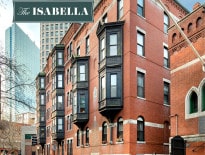
Nearly half of income-restricted units created under Boston’s inclusionary development policy are located in three neighborhoods, including the Seaport District. The 346-unit Watermark Seaport apartment tower, completed in 2016, contains 45 affordable units.
Aided by a bustling multifamily building climate and more aggressive affordable housing requirements on private development, Boston has added more than 1,800 income-restricted apartments and condos in the past three years.
City officials credit their updated inclusionary development policy for stabilizing rents and generating affordable and workforce housing in high-cost areas such as downtown and the Seaport District. Housing advocates are split on the policy’s effects, with some seeing downward pressure on rents across the board while others warn of continuing gentrification and displacement.
“It’s always hard to figure out what the appropriate amount of affordable units to put into a development,” said Carol Ridge Martinez, executive director of the Allston-Brighton Community Development Corp. “The city worked really hard to find out where the sweet spot was for that, to keep development from going out of Boston to other places and maintaining the affordability (guidelines) that they could.”
The city’s inclusionary development policy was updated in January 2016 with new requirements on developers of multifamily projects containing 10 or more units, including higher fees for projects that choose not to include the required minimum 13 percent of income-restricted units on-site. About a quarter of projects include payments to support development of off-site units, which can be applied to projects anywhere in the city. Developers also can opt to build off-site affordable units in the same neighborhood.
“As market-rate condo prices have gotten to stratospheric levels, more and more condo developers want to do off-site,” said Tim Davis, housing policy manager for the Boston Planning and Development Agency.
The new policy raised the off-site fee from $200,000 to $380,000 per unit in the highest-cost neighborhoods. The fees collect in the IDP fund, which is administered by the city’s Department of Neighborhood Development.
Even with the higher fee scale, developers contributed $23.7 million to the IDP fund in 2016, nearly a quarter of the $73.1 million total collected since 2000. Future projects approved by the BPDA in 2016 tallied another $42.8 million.
“To DND’s credit, they figured out what was a reasonable push before the developers started yelling,” said Rich Giordano, director of community organizing at the Fenway Community Development Corp.
Typically, income-restricted apartments built under the IDP are reserved for households making 70 percent of the area median income, or $57,950 for a two-person household. Fenway CDC advocated a lower income tier of 60 percent AMI, but Giordano acknowledged concerns about whether developers could obtain financing given the lower rent stream.
The market-driven approach to housing generation reflects a strategy of increasing supply to tame rent increases in Boston, which consistently ranks among the nation’s top four priciest apartment markets. Boston has added nearly 22,000 housing units of all types since 2014, according to city data, including more than 8,000 units that are currently under construction. Yet income-restricted units built under the IDP since 2000 still account for less than 1 percent of the city’s housing stock.
Officials still see the program as a cost-effective way to generate affordable housing by leveraging private investment, given limited availability of federal Community Development Block Grant and HOME funds, which the city relied on in previous decades.
Some housing activists say the development boom is driving up rents of nearby properties even in once-affordable neighborhoods and accelerating displacement.
“Supply and demand may be true in an overarching sense, but construction of a large number of luxury units drives up rents of the surrounding units,” said Steve Meacham, organizing coordinator for Jamaica Plain tenant coalition City Life Vida Urbana.
Nearly half of all IDP units have been built in just three neighborhoods: South Boston (including the Seaport), the downtown area and the South End. During a press briefing last week to release a report on the IDP’s performance, city officials touted the ability to generate lower-cost housing close to job centers and public transit.
But Meacham said the benefits have been harder to detect in traditionally lower-cost neighborhoods.
“You can produce many more units somewhere else than downtown, and that’s one of the problems of the IDP,” he said. “It’s based where the housing boom is – downtown – and it gives so much short shrift to the other neighborhoods.”
But Ridge Martinez said Allston-Brighton’s renters have benefited from the increasing inventory.
“We’re seeing rents not escalate as much as they had previously, and in some cases decrease,” she said. “It’s definitely the supply and demand.”
The program’s income guidelines fail to address the housing affordability crisis among lower-income residents, according to research by Justin Steil, an assistant professor of law and urban planning at Massachusetts Institute of Technology.
Three-quarters of Boston households earning below 30 percent of AMI are paying more than 30 percent of their income in gross rent, the threshold that the U.S. Department of Housing and Urban Development uses to classify those in need of affordable housing. More than half pay over 50 percent of their income in housing costs, while median gross rent has increased from $1,030 a month in 2009 to $1,186 in 2015, according to U.S. Census Bureau data.
“The greatest need is at the lower income levels that the IDP doesn’t affect,” Steil said.




 |
| 


